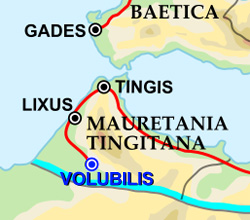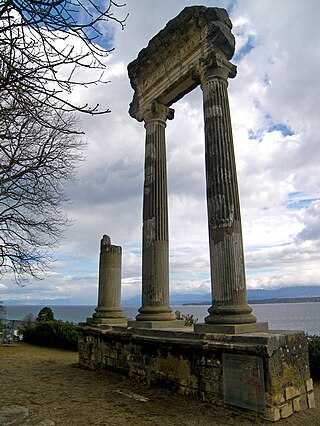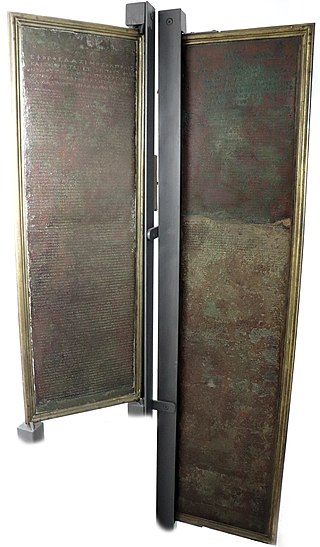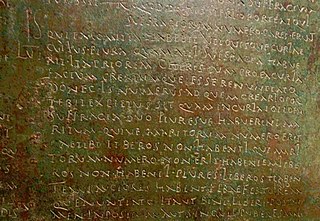
Lusitania was an ancient Iberian Roman province encompassing most of modern-day Portugal and a large portion of western Spain. Romans named the region after the Lusitanians, an Indo-European tribe inhabiting the lands.
This article concerns the period 69 BC – 60 BC.
This article concerns the period 79 BC – 70 BC.
This article concerns the period 19 BC – 10 BC.
This article concerns the period 29 BC – 20 BC.

Legio X Gemina, was a Roman legion, which was active during the late Roman Republic and later the Roman Empire as part of the Imperial Roman army. It was one of the four legions used by Julius Caesar in 58 BC, during the Roman invasion of Gaul. After being briefly disbanded, the legion was reconstituted by Augustus and fought on the side of the Second Triumvirate during the Liberators' Civil War and later on the side of Augustus during the War of Actium which ended the Crisis of the Roman Republic. The legion remained active for centuries, with surviving records of its continued existence in Vienna as late as the 5th century AD. The legion's symbol was a bull. Early on in its history, the legion was called X Equestris (mounted), because Caesar once used the legionaries as cavalry.

Hispania Tarraconensis was one of three Roman provinces in Hispania. It encompassed much of the northern, eastern and central territories of modern Spain along with modern northern Portugal. Southern Spain, the region now called Andalusia, was the province of Hispania Baetica. On the Atlantic west lay the province of Lusitania, partially coincident with modern-day Portugal.
Gaius Trebonius was a military commander and politician of the late Roman Republic, who became suffect consul in 45 BC. He was an associate of Julius Caesar, having served as his legate and having fought on his side during the civil war, and was among the tyrannicides who killed the dictator.
Quintus Pedius was a Roman politician and general who lived during the late Republic. He served as a military officer under Julius Caesar for most of his career. Serving with Caesar during the civil war, he was elected praetor in 48 BC and was given a triumph for victories over the Pompeians during the civil war's second Spanish campaign.

Latin rights or Latin citizenship were a set of legal rights that were originally granted to the Latins and therefore in their colonies. Latinitas was commonly used by Roman jurists to denote this status. With the Roman expansion in Italy, many settlements and coloniae outside of Latium had Latin rights.

Tingis or Tingi, the ancient name of Tangier in Morocco, was an important Carthaginian, Moor, and Roman port on the Atlantic Ocean. It was eventually granted the status of a Roman colony and made the capital of the province of Mauretania Tingitana and, after Diocletian's reforms, the diocese of Hispania.

Osuna is a town and municipality in the province of Seville, southern Spain, in the autonomous community of Andalusia. As of 2009, it has a population of c. 17,800. It is the location of the Andalusian Social Economy School.
Gaius Vibius Pansa Caetronianus was consul of the Roman Republic in 43 BC. Although supporting Gaius Julius Caesar during the Civil War, he pushed for the restoration of the Republic upon Caesar’s death. He died of injuries sustained at the Battle of Forum Gallorum.

Noviodunum or Colonia Iulia Equestris was a Roman era settlement in what is now Nyon in the Canton of Vaud in Switzerland.

The Romanization of Hispania is the process by which Roman or Latin culture was introduced into the Iberian Peninsula during the period of Roman rule.

The Heraclean Tablets are bronze tablets found a short distance from the site of Heraclea Lucania, in the direction of Metapontum. They are significant for the study of Roman Law.
The lex Irnitana consists of fragments of Roman municipal laws dated to AD 91 which had been inscribed on a collection of six bronze tablets found in 1981 near El Saucejo, Spain. Together with the Lex Salpensana and the Lex Malacitana it provides the most complete version of the lex Flavia municipalis, or the Flavian municipal law. and has allowed new insights into the workings of Roman law. The tablets are exhibited in the Archeological Museum of Seville. Since the tablets provide the only surviving copy of large parts of the Flavian municipal law, they have provided new insights into the procedural side of municipal courts.

Lex Malacitana or Lex Flavia Malacitana is a bronze tablet bearing Latin local statutes which deal with the official activities of the duoviri iuri dicundo. The tablet was found in the 20th century near Malaca with the lex Salpensana, and it was dated from AD 81–84, i.e. the early reign of Domitian. Malaca was governed under this law, which granted free-born persons the privileges of Roman citizenship.
The Bronze of Ascoli was a bronze tablet discovered in Asculum (Ascoli), Rome in 1908, which became notable for the study of the ancient Iberian language, because it contained the names of Iberian horsemen of the Turma Salluitana, who received Roman citizenship in 89 BCE after their participation in the siege of Asculum.

In ancient Rome, a tabula patronatus was a tablet, usually bronze, displaying an official recognition that an individual was a municipal patron.











